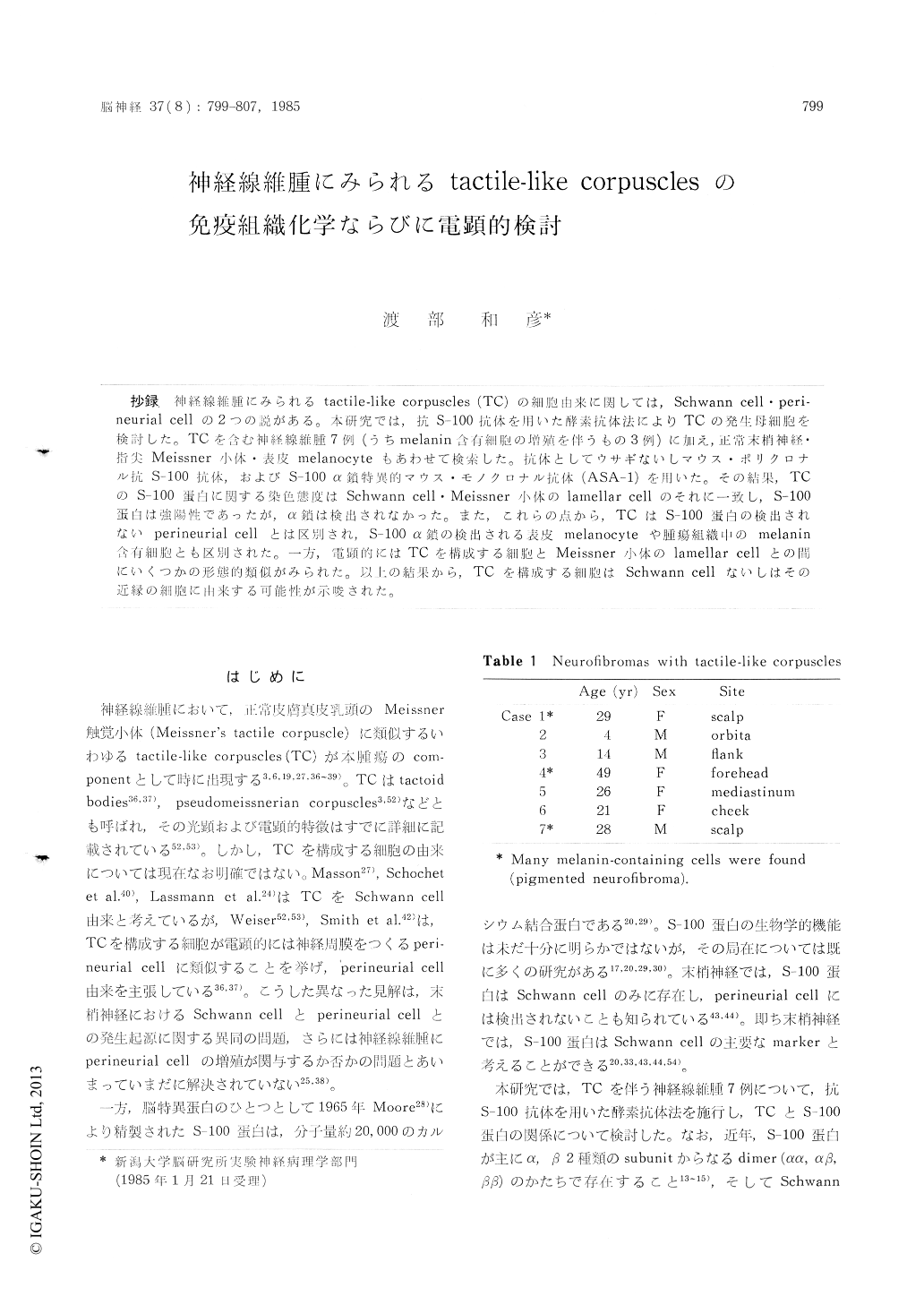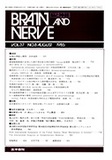Japanese
English
- 有料閲覧
- Abstract 文献概要
- 1ページ目 Look Inside
抄録 神経線維腫にみられるtactile-like corpuscles (TC)の細胞由来に関しては,Schwann cell・peri—neurial cellの2つの説がある。本研究では,抗S−100抗体を用いた酵素抗体法によりTCの発生母細胞を検討した。TCを含む神経線維腫7例(うちmelanin含有細胞の増殖を伴うもの3例)に加え,正常末梢神経・指尖Meissner小体・表皮melanocyteもあわせて検索した。抗体としてウサギないしマウス・ポリクロナル抗S−100抗体,およびS−100α鎖特異的マウス・モノクロナル抗体(ASA−1)を用いた。その結果,TCのS−100蛋白に関する染色態度はSchwann cell・Meissner小体のlamellar cellのそれに一致し,S−100蛋白は強陽性であったが,α鎖は検出されなかった。また,これらの点から,TCはS−100蛋白の検出されないperineurial cellとは区別され,S−100α鎖の検出される表皮melanocyteや腫瘍組織中のmelanin含有細胞とも区別された。一方,電顕的にはTCを構成する細胞とMeissner小体のlamellar cellとの間にいくつかの形態的類似がみられた。以上の結果から,TCを構成する細胞はSchwann cellないしはその近縁の細胞に由来する可能性が示唆された。
Morphological characteristics of tactile-like corpuscles (tactoid bodies, pseudomeissnerian cor-puscles) which are occasionally present in neuro-fibromas have already been detailed. However, there has yet been controversy on the cytogenesis of these lamellated structures. Probably, one of the most important problems is whether tactile-like corpuscles are composed of Schwann cells or of perineurial cells.
In this study, seven cases of neurofibromas with tactile-like corpuscles were examined by rabbit or mouse polyclonal antisera to S-100 pro-tein which could be regarded, at least in the peripheral nervous system, as a specific marker for Schwann cells. Since recent extensive studies have revealed that S-100 protein is a mixture of two predominant dimeric components with S-100 a and S-100 βsubunits, and the S-100 a subunit is absent from Schwann cells, tactile-like corpuscles were also examined by a mouse monoclonal antibody (ASA-1) specific for the S-100 a subunit.
For immunohistochemical analysis, peripheral nerves, Meissner corpuscles and epidermal melano-cytes were also examined in parallel.
By the immunoperoxidase method using rabbit or mouse polyclonal antisera to S-100 protein, tactile-like corpuscles were intensely stained in sections from all seven cases. Both the flattened cell bodies and the eccentrically located nuclei of their constituent cells were stained. In the background neurofibroma tissue surrounding the tactile-like corpuscles, spindle-shaped cells were stained variably. In three of the seven cases, numerous melanin-containing cells which often surrounded the tactile-like corpuscles were also stained. In normal peripheral nerves, positive staining was confined to Schwann cells and their processes. Perineurial cells were not stained. In Meissner corpuscles of the finger bellies, positive staining was observed in lamellar cells which are widely accepted as Schwann-related cells. There was no distinct staining of a cup-shaped capsule which has been considered to be formed from perineurial cells. In the epidermis of human finger bellies, melanocytes were also stained.
By the immunoperoxidase method using the mouse monoclonal antibody (ASA-1) to the S-100 a subunit, no immunoreactivity was observed in the tactile-like corpuscles as well as Schwann cells in the peripheral nerves and lamellar cells in the Meissner corpuscles, suggesting that these cells and structures are equally devoid of the S-100 a subunit. By contrast, numerous melanin-containing cells observed in the three cases were stained as well as epidermal melanocytes of human finger bellies.
These immunoperoxidase findings could be summarized as follows : immunoreactivity of the tactile-like corpuscles for S-100 protein coincides with that of Schwann cells or Schwann-related cells such as lamellar cells of the Meissner corpuscle ; the constituent cells of these structures differ from perineurial cells in that S-100 protein is not detected in the latter and also differ from melanocytes or melanin-containing cells in that S-100 a subunit is detected in these. Therefore this seemed to indicate Schwannian, but not perineurial or melanocytic, nature of the tactile-like corpuscles.
Electron-microscopic examination was also per-formed on one of the seven neurofibroma cases and Meissner corpuscles of human finger bellies. There were several ultrastructural similarities between constituent cells of the tactile-like cor-puscles and lamellar cells of the Meissner corpuscle, such as many smooth-surfaced vesicles, incomplete basal lamina, desmosomes and hemidesmosome-like densities. Although these morphological characteristics are also shared by perineurial cells, the ultrastructural similarity of constituent cells of the tactile-like corpuscles to Schwann-related cells such as lamellar cells of the Meissner corpuscle seemed to be an additional support for the above-mentioned consideration drawn from the immunoperoxidase findings.
In summary, the present immunoperoxidase and electron-microscopic findings may indicate that the tactile-like corpuscles in neurofibromas are composed of Schwann or Schwann-related cells.

Copyright © 1985, Igaku-Shoin Ltd. All rights reserved.


